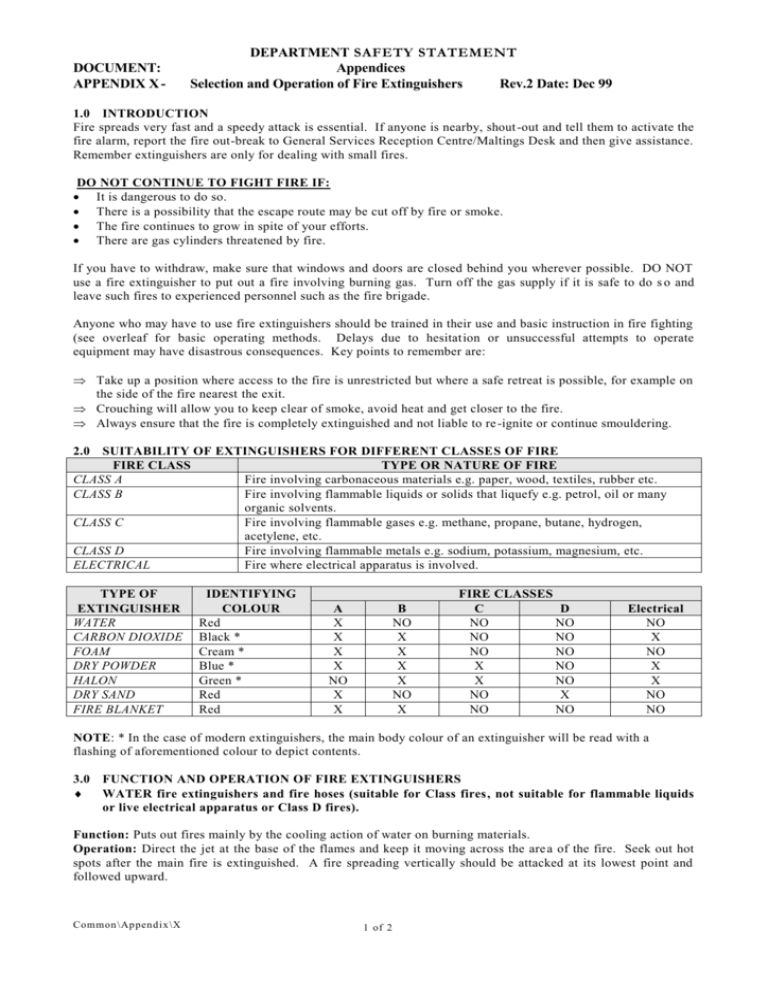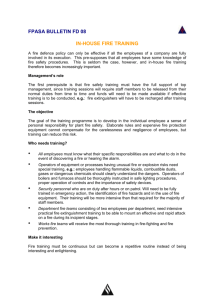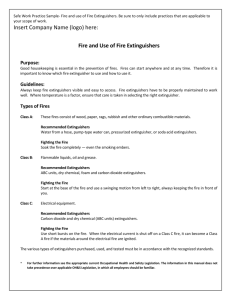fire class
advertisement

DOCUMENT: APPENDIX X - DEPARTMENT SAFETY STATEMENT Appendices Selection and Operation of Fire Extinguishers Rev.2 Date: Dec 99 1.0 INTRODUCTION Fire spreads very fast and a speedy attack is essential. If anyone is nearby, shout -out and tell them to activate the fire alarm, report the fire out-break to General Services Reception Centre/Maltings Desk and then give assistance. Remember extinguishers are only for dealing with small fires. DO NOT CONTINUE TO FIGHT FIRE IF: It is dangerous to do so. There is a possibility that the escape route may be cut off by fire or smoke. The fire continues to grow in spite of your efforts. There are gas cylinders threatened by fire. If you have to withdraw, make sure that windows and doors are closed behind you wherever possible. DO NOT use a fire extinguisher to put out a fire involving burning gas. Turn off the gas supply if it is safe to do s o and leave such fires to experienced personnel such as the fire brigade. Anyone who may have to use fire extinguishers should be trained in their use and basic instruction in fire fighting (see overleaf for basic operating methods. Delays due to hesitat ion or unsuccessful attempts to operate equipment may have disastrous consequences. Key points to remember are: Take up a position where access to the fire is unrestricted but where a safe retreat is possible, for example on the side of the fire nearest the exit. Crouching will allow you to keep clear of smoke, avoid heat and get closer to the fire. Always ensure that the fire is completely extinguished and not liable to re -ignite or continue smouldering. 2.0 SUITABILITY OF EXTINGUISHERS FOR DIFFERENT CLASSES OF FIRE FIRE CLASS TYPE OR NATURE OF FIRE CLASS A Fire involving carbonaceous materials e.g. paper, wood, textiles, rubber etc. CLASS B Fire involving flammable liquids or solids that liquefy e.g. petrol, oil or many organic solvents. CLASS C Fire involving flammable gases e.g. methane, propane, butane, hydrogen, acetylene, etc. CLASS D Fire involving flammable metals e.g. sodium, potassium, magnesium, etc. ELECTRICAL Fire where electrical apparatus is involved. TYPE OF EXTINGUISHER WATER CARBON DIOXIDE FOAM DRY POWDER HALON DRY SAND FIRE BLANKET IDENTIFYING COLOUR Red Black * Cream * Blue * Green * Red Red A X X X X NO X X B NO X X X X NO X FIRE CLASSES C D NO NO NO NO NO NO X NO X NO NO X NO NO Electrical NO X NO X X NO NO NOTE: * In the case of modern extinguishers, the main body colour of an extinguisher will be read with a flashing of aforementioned colour to depict contents. 3.0 FUNCTION AND OPERATION OF FIRE EXTINGUISHERS WATER fire extinguishers and fire hoses (suitable for Class fires, not suitable for flammable liquids or live electrical apparatus or Class D fires). Function: Puts out fires mainly by the cooling action of water on burning materials. Operation: Direct the jet at the base of the flames and keep it moving across the are a of the fire. Seek out hot spots after the main fire is extinguished. A fire spreading vertically should be attacked at its lowest point and followed upward. Common \Appendix\X 1 of 2 DOCUMENT: APPENDIX X Appendices Selection and Operation of Fire Extinguishers (Cont.) Rev.2 Date:Dec 99 CARBON DIOXIDE, HALON and DRY POWDER fire extinguishers (suitable for Class B fires involving flammable liquids or electrical fires). Function: Carbon dioxide extinguishers smother combustion by displacement of atmospheric oxygen. Halon 1211 (BCF) extinguishers release vaporising liquids, which chemically inhibits combustion. Dry Powder extinguishers work by knocking down flames and smothers combustion by a combination of oxygen displacement and chemically inhibiting combustion. Please note: 1. These extinguishers do not cool fires very well and fires may re-ignite later again. Ensure fire is fully out. 2. Carbon Dioxide (CO2) or Halon extinguishers should NOT be used in confined spaces as there is a danger of asphyxiation by inhaling gases. Rooms should be immediately ventilated after extinguishing the fire/discharge of the extinguisher. Operation: On fires involving either liquids in containers or spilled liquids, direct the jet or discharge horn towards the near edge of fire. With a rapid sweeping motion, drive the fire towards the far edge until all the flames are extinguished (see note above). On fires in falling liquids, direct the jet or horn at the base of the flames and sweep upwards. On fires in electrical equipment, switch off the current and direct the jet or horn at the fire. Where the equipment is enclosed, direct the jet or horn into any opening to penetrate the inside. FOAM extinguishers [two types (a) foam suitable for Class B fires involving flammable liquids and (b) AFFF Aqueous Film Forming foams suitable for Class A & B fires]. Function: Forms a blanket of foam over the surface of the burning liquid, which smothers the fire. NOTE: Special foams are required for fighting fires in flammable liquids that are miscible with water. Operation: Where the liquid is on fire in a container, direct the jet at the inside edge (far edge) of the container or at an adjoining vertical surface (wall) above the level of the burning liquid. The breaks the jet and allows the foam the build up and flow across the surface of the liquid to smother the fire. Where this is not possible, stand well back, direct the jet with a gentle sweeping movement, allow the foam to drop down and lie on the surface of the liquid. Do not aim the jet directly into the liquid as this will drive the foam beneath the surface and render it ineffective. In addition, it may splash the fire onto the surroundings. FIRE blankets (suitable for Class A and B fires) Function: Smothers the fire by oxygen starvation. Operation: Place carefully over small fires e.g. small spillages of liquids or clothing. Keep hands protected from the fire. Do not waft the fire in your direction. Do not remove the blanket to see that if the fire is out, as the fire may reignite – wait until you’re sure that the liquid is cold and the fire is fully extinguished. DRY SAND: (suitable for Class A and Class D fires) Function: Smothers the gas by oxygen starvation. In the case of burning metals like Lithium, metal hydrides, metal alkyls or other organometallics, there are special fire extinguishers for Class D fires e.g. Met-L-X® which also are of granular formulations. Operation: Place sand carefully over small fire using bucket or supplier’s recommended method. Common \Appendix\X 2 of 2



